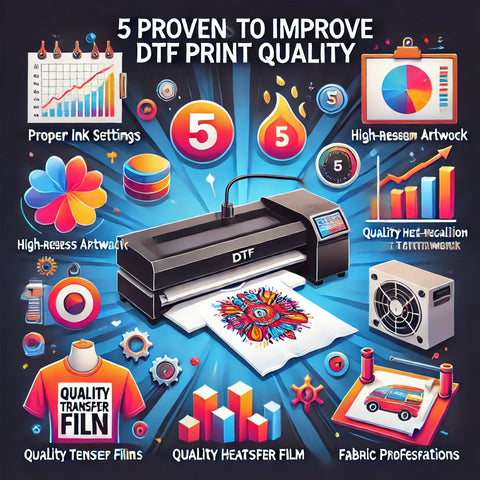DTF printing (Direct-to-Film) is a powerful and versatile printing method, but achieving high-quality results requires more than just pressing a design onto fabric.
If you're experiencing faded colors, cracks, or uneven prints, don’t worry! By following these five expert tips, you can dramatically improve DTF print quality and make your products stand out.
Let’s dive in!
1. Use High-Quality DTF Film & Ink
✔ Why It Matters:
Your print quality is only as good as the materials you use. Cheap films and low-quality inks can lead to faded colors, weak adhesion, and short-lasting prints.
✔ How to Improve:
✅ Choose premium DTF film – Look for matte, high-release films for better ink adhesion.
✅ Use high-opacity, pigment-rich inks – Ensures vibrant and durable colors.
✅ Buy from trusted brands – Avoid generic, low-cost options that reduce quality.
📌 Pro Tip: Always match your ink brand with your printer’s manufacturer recommendations to avoid clogging and inconsistencies.
2. Optimize Your Heat Press Settings
✔ Why It Matters:
Even with high-quality ink and film, incorrect temperature, pressure, or pressing time can ruin your print.
✔ How to Improve:
✅ Set the correct temperature – Most DTF transfers require 160-180°C (320-356°F).
✅ Use medium to high pressure – Ensures strong adhesion to the fabric.
✅ Press for the right duration – Usually 10-15 seconds, but depends on your material.
✅ Cold Peel or Hot Peel? – Some DTF films require cooling before peeling, while others work best when peeled hot.
📌 Pro Tip: Always do a test press on scrap fabric before running large orders to adjust settings if needed.
3. Maintain Your DTF Printer Regularly
✔ Why It Matters:
A clogged printhead or poorly maintained printer will cause streaks, color fading, and banding in your designs.
✔ How to Improve:
✅ Perform daily printhead cleanings – Prevents ink buildup and clogging.
✅ Use a humidifier in dry environments – Keeps ink from drying out inside the printer.
✅ Shake your white ink daily – Prevents pigment separation and weak opacity.
✅ Run test prints before production – Helps identify nozzle clogs or misalignments early.
📌 Pro Tip: If you’re experiencing color inconsistencies, check if your printheads are properly aligned and run a nozzle check.
4. Improve Color Accuracy with ICC Profiles
✔ Why It Matters:
Without proper ICC color profiles, your prints may look dull or different from your digital design.
✔ How to Improve:
✅ Use ICC color profiles – Ensures your printer, ink, and film produce true-to-life colors.
✅ Calibrate your monitor – Avoid color mismatches between screen and print.
✅ Adjust ink saturation in RIP software – Fine-tune vibrancy and contrast for perfect prints.
📌 Pro Tip: If colors look off, print a test swatch with different saturation levels to see which works best.
5. Choose the Right Fabric & Pre-Treat When Necessary
✔ Why It Matters:
Not all fabrics work equally well with DTF printing. The right material can enhance durability and vibrancy, while the wrong one can cause poor adhesion and fading.
✔ How to Improve:
✅ Use cotton, polyester, or blends – These fabrics work best for DTF prints.
✅ Pre-treat synthetic fabrics – Helps ink adhere strongly to smooth materials.
✅ Wash test your products – Ensures prints stay vibrant and intact after multiple washes.
📌 Pro Tip: Avoid low-quality fabrics with excess lint, as they can cause uneven prints and weak adhesion.
Final Thoughts: How to Get the Best DTF Print Quality
📌 Key Takeaways:
✔ Use high-quality film and ink to prevent fading and cracking.
✔ Optimize heat press settings for proper adhesion and durability.
✔ Keep your DTF printer clean to avoid streaks and poor color output.
✔ Utilize ICC profiles and RIP software for accurate color reproduction.
✔ Choose the right fabrics and pre-treat when needed for long-lasting prints.
🚀 Want premium-quality DTF transfers? Check out our high-opacity, durable transfers that ensure vibrant colors and long-lasting results!






